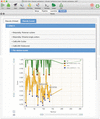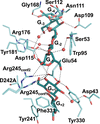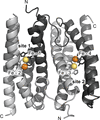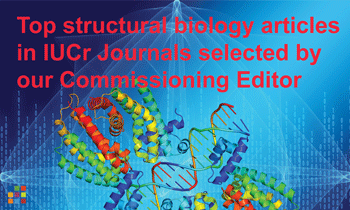issue contents
February 2022 issue

Cover illustration: Radiation-induced defects in protein crystals observed by X-ray topography [Suzuki et al. (2022), Acta Cryst. D78, 196–203]. This X-ray topograph of glucose isomerase following irradiation shows bead-like line contrasts clearly visible along the irradiation paths. The demonstration of crystal defects induced by X-ray irradiation could help to understand the underlying mechanisms of X-ray-induced radiation damage.
CCP-EM
Open  access
access
 access
accessA perspective is provided on the future development of real-space methods in cryo-EM.
CCP4
Open  access
access
 access
accessThe types, scopes, availability and complementarity of databases for intrinsically disordered proteins are described.
Open  access
access
 access
accessUtilities for atomic model validation in the CCP-EM software suite are discussed. An assessment of SARS-CoV-2 structures reflects a strong bias in model refinement towards geometric restraints when compared with agreement with the data.
high-pressure crystallography
Urate oxidase structures under high hydrostatic pressure per se and high argon pressure have been analyzed, deciphering the basis of protein–ligand stabilization by pressure and the formation of a transient intermediate dimeric substate during pressure-induced dissociation.
research papers
An end-to-end supervised learning method to directly recover missing orientations from 2D cryo-EM images is described.
Open  access
access
 access
accessA program utilizing artificial learning and convolutional neural networks, named Helcaraxe, has been developed which can detect ice-crystal artefacts in processed macromolecular diffraction data with unprecedented accuracy.
The direct observation of crystal defects in protein crystals induced solely by X-ray irradiation is reported.
In a pilot study, K-edge anomalous SAXS signal was obtained from a small dimeric protein containing polyhistidine tags bound to cupric ions, which can be used for the assessment of protein structural models in solution.
Open  access
access
 access
accessThe first structure of a novel archaeal-like Holliday junction-resolving enzyme originating from a thermophilic phage was determined and its function in cleaving X-shaped dsDNA was demonstrated. Furthermore, a novel signature motif for Holliday junction-resolving enzymes originating from thermophilic bacteriophages is proposed.
Open  access
access
 access
accessThe structure of an endo-β-1,4-glucanase from the cellulose-producing bacterium Enterobacter sp. CJF-002 bound to cellooligosaccharide was determined.
Open  access
access
 access
accessUsing spatially resolved anomalous dispersion (SpReAD) refinement, the oxidation states of elements in crystal structures can be determined.
The crystal structure of guanosine monophosphate synthase from Aspergillus fumigatus, an attractive antifungal drug target, reveals unique differences from the human homologue that can be effectively targeted.
PDB reference: guanosine monophosphate synthase, 7mo6
essays
Open  access
access
 access
accessThe streamlined crystallographic software tools for solving macromolecular crystal structures should be complemented with the visual aids that were used in the past (for example precession images and stereographic projections) to facilitate better understanding of the basic crystallographic concepts by younger aspiring crystallographers.


 journal menu
journal menu































